Biometrics in online media: an anti-crisis paradigm shift
- 作者: Shilina S.G.1
-
隶属关系:
- Paradigm Research
- 期: 卷 28, 编号 4 (2023): Media and Crisis – Reversible Paradigms
- 页面: 741-748
- 栏目: JOURNALISM
- URL: https://journal-vniispk.ru/2312-9220/article/view/319109
- DOI: https://doi.org/10.22363/2312-9220-2023-28-4-741-748
- EDN: https://elibrary.ru/KOLCJF
- ID: 319109
如何引用文章
全文:
详细
Online media is currently grappling with a crisis characterized by diminishing trust, the widespread dissemination of misinformation, and the alarming proliferation of fake news and experiences. The aim of the study - to delve into the challenges plaguing the digital media landscape and to propose the adoption of biometric technology as a potential solution. Biometrics, as a cutting-edge technology, encompasses the intricate process of quantifying and statistically assessing the unique physical and behavioral characteristics that distinguish individuals from one another. Its multifaceted potential extends far beyond mere identification. It is established that biometrics excels in the vital realms of identity verification, content authentication, and countering malicious activities like bots and Sybil attacks. Furthermore, it is applicable for tailoring personalized user experiences, thus offering a comprehensive solution to address the pressing challenges faced by online media today. The usage of these capabilities, makes biometrics a distinctive and promising avenue to not only restore trust but also combat the pervasive issue of misinformation, ultimately fostering a secure and resilient online media ecosystem.
作者简介
Sasha Shilina
Paradigm Research
编辑信件的主要联系方式.
Email: sasha@paradigmfund.io
ORCID iD: 0000-0003-4696-0739
Ph.D. in Philology, Chief Research Officer
86 Gorgasali St, Batumi, 6000, Georgia参考
- Aldayel, A., & Magdy, W. (2022). Characterizing the role of bots’ in polarized stance on social media. Social Network Analysis and Mining, 12, 30. https://doi.org/10.1007/s13278-022-00858-z
- Algavi, L., Volkova, I., Kovalev, G., & Budtsov, G. (2023). Qanon as a transmedia story-telling. Media Education, 19(1), 3-9. https://doi.org/10.13187/me.2023.1.3
- Aljabri, M., Zagrouba, R., Shaahid, A., Alnasser, F., Saleh, A., & Alomari, D.M. (2023) Machine learning-based social media bot detection: A comprehensive literature review. Social Network Analysis and Mining, 13, 20. https://doi.org/10.1007/s13278-022-01020-5
- Shin, J., & Chan-Olmsted, S. (2023). User perceptions and trust of explainable machine learning fake news detectors. Journal of Communication, 17, 518-540.
- Cherrat, E., Alaoui, R., & Bouzahir, H. (2020). Convolutional neural networks approach for multimodal biometric identification system using the fusion of fingerprint, finger-vein and face images. PeerJ Computer Science, 6, e248. https://doi.org/10.7717/peerj-cs.248
- Cresci, S., Di Pietro, R., Petrocchi, M., Spognardi, A., & Tesconi, M. (2017). Paradigm-shift of social spambots: Evidence, theories, and tools for the arms race. WWW '17 Companion: Proceedings of the 26th International Conference on World Wide Web Companion (pp. 963-972). https://doi.org/10.1145/3041021.3055135
- Del Vicario, M., Bessi, A., Zollo, F., Petroni, F., Scala, A., Caldarelli, G., Stanley, H.E., & Quattrociocchi, W. (2016). The spreading of misinformation online. Proceedings of the National Academy of Sciences, 113(3), 554-559. https://doi.org/10.1073/pnas.1517441113
- Di Domenico, G., Sit, J., Ishizaka, A., & Nunan, D. (2021). Fake news, social media and marketing: A systematic review. Journal of Business Research, 124, 329-341. https://doi.org/10.1016/j.jbusres.2020.11.037
- Douceur, J.R. (2002). The Sybil attack. In P. Druschel, F. Kaashoek, & A. Rowstron (Eds.), Peer-to-Peer Systems. IPTPS 2002. Lecture Notes in Computer Science (vol. 2429, pp. 251-260). Berlin, Heidelberg: Springer. https://doi.org/10.1007/3-540-45748-8_24
- Engelke, K.M., Hase, V., & Wintterlin, F. (2019). On measuring trust and distrust in journalism: Reflection of the status quo and suggestions for the road ahead. Journal of Trust Research, 9(1), 66-86. https://doi.org/10.1080/21515581.2019.1588741
- Ferrara, E. (2018). Measuring social spam and the effect of bots on information diffusion in social media. Complex Spreading Phenomena in Social Systems (pp. 229-255). Cham: Springer. https://doi.org/10.1007/978-3-319-77332-2_13
- Fink, K. (2019). The biggest challenge facing journalism: A lack of trust. Journalism, 20(1), 40-43. https://doi.org/10.1177/14648849188070
- Jin, J. (2022). Convolutional neural networks for biometrics applications. SHS Web of Conferences: 2022 International Conference on Science and Technology Ethics and Human Future, 144, 03013. https://doi.org/10.1051/shsconf/202214403013
- Kaur, G., & Verma, C.K. (2014). Comparative analysis of biometric modalities. International Journal of Advanced Research in Computer Science and Software Engineering, 4(4).
- Kavazi, D., Smirnov, V., Shilina, S., MOZGIII, Li, M., Contreras, R., Gajera, H., Lavrenov, D. (2021). Humanode. Whitepaper v. 0.9.6 “You are [not] a bot”. https://doi.org/10.13140/RG.2.2.25572.91528
- Kolo, C., Mütterlein, J., & Schmid, S.A. (2022). Believing journalists, AI, or fake news: The role of trust in media. Proceedings of the 55th Hawaii International Conference on System Sciences. Retrieved September 21, 2023, from http://hdl.handle.net/10125/79727
- Park, S., Fisher, C., Flew, T., & Dulleck, U. (2020). Global mistrust in news: The impact of social media on trust. International Journal on Media Management, 22(2), 83-96. https://doi.org/10.1080/14241277.2020.1799794
- Pennycook, G., & Rand, D.G. (2021). The psychology of fake news. Trends in Cognitive Sciences, 25(5), 388-402. https://doi.org/10.1016/j.tics.2021.02.007
- Prochazka, F., & Schweiger, W. (2019). How to measure generalized trust in news media? An adaptation and test of scales. Communication Methods and Measures, 13(1), 26-42. https://doi.org/10.1080/19312458.2018.1506021
- Raheem, E.A., Ahmad, S.M.S., & Adnan, W.A.W. (2019). Insight on face liveness detection: A systematic literature review. International Journal of Electrical and Computer Engineering, 9(6), 5865. http://doi.org/10.11591/ijece.v9i6.pp5165-5175
- Shao, C., Ciampaglia, G.L., Varol, O., Yang, K., Flammini, A., & Menczer, F. (2018). The spread of low-credibility content by social bots. Nature Communications, 9, 4787. https://doi.org/10.1038/s41467-018-06930-7
- Thakur, S., & Breslin, J.G. (2021). Rumour prevention in social networks with layer 2 blockchains. Social Network Analysis and Mining, 11, 104. https://doi.org/10.1007/s13278-021-00819-y
- Usher, N. (2018). Re-thinking trust in the news: A material approach through “Objects of Journalism”. Journalism Studie, 19(4), 564-578. https://doi.org/10.1080/1461670X.2017.1375391
- Volkova, I.I., & Lazutova, N.M. (2017). Screen media and human ecology: From charming to joining. Bulletin of Orenburg State University, (12), 106-111. (In Russ.) 10.25198/1814-6457-212-106' target='_blank'>https://doi: 10.25198/1814-6457-212-106
- Vosoughi, S., Roy, D., & Aral, S. (2018). The spread of true and false news online. Science, 359(6380), 1146-1151. https://doi.org/10.1126/science.aap95
- Zhang, X., & Ghorbani Ali, A. (2020). An overview of online fake news: Characterization, detection, and discussion. Information Processing & Management, 57(2). https://doi.org/10.1016/j.ipm.2019.03.004
补充文件









